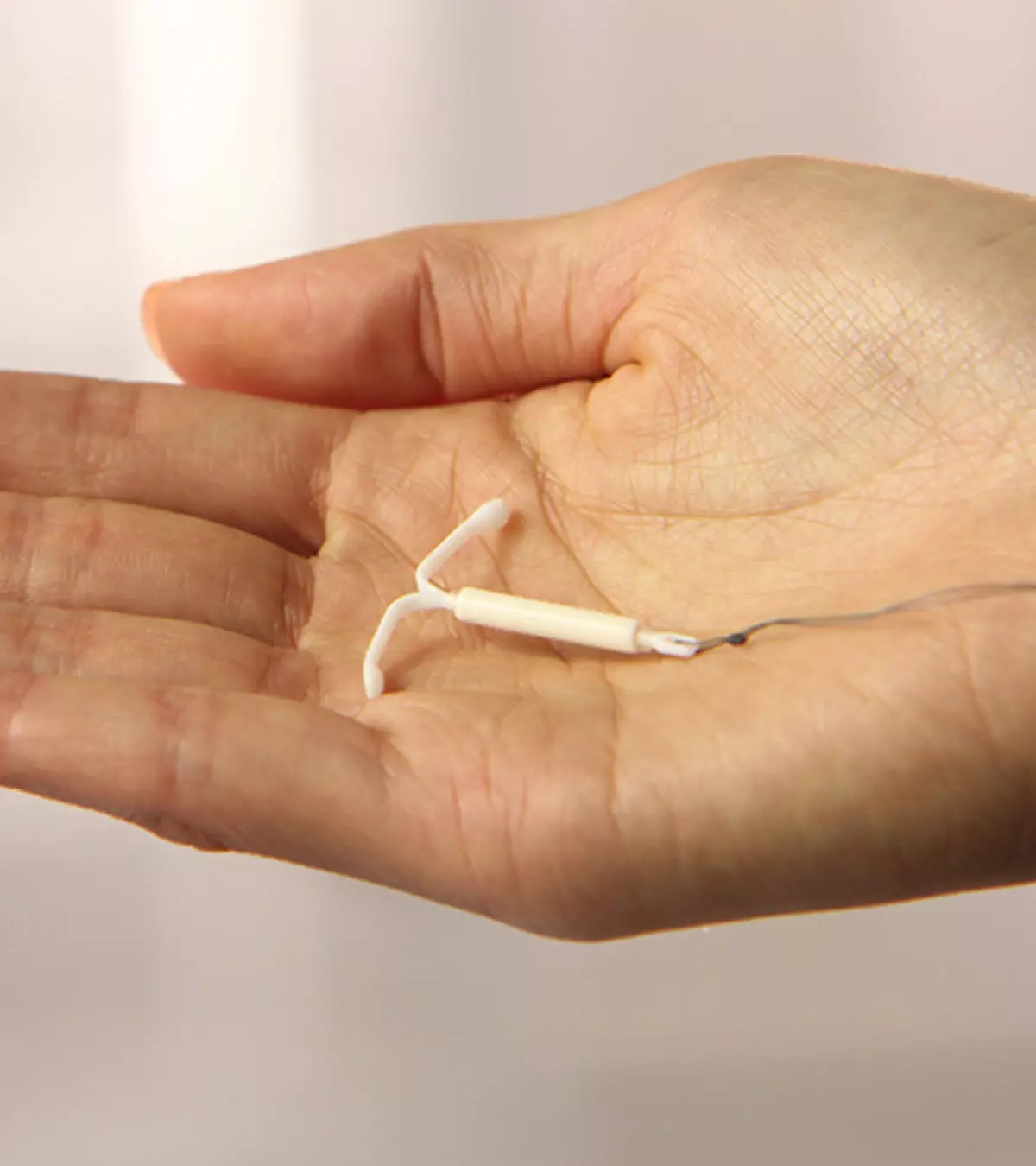
Image: ShutterStock
Sandifer syndrome in babies is a rare gastrointestinal disorder associated with gastroesophageal reflux (GER) and other symptoms such as abnormal head position or abnormal movements of the head, neck, and upper part of the trunk (1). These unusual neck movements may be misdiagnosed as an epileptic seizureiHaving two or more seizures of unknown origin . Recognizing its characteristic signs is crucial, as Sandifer syndrome is often mistaken for seizures, leading to unnecessary interventions. However, it is not a neurological condition and usually resolves as the baby grows. Read the post to know more about the symptoms, causes, diagnosis, and treatment of Sandifer syndrome in babies.

Key Pointers
- Sandifer syndrome is a rare gastrointestinal condition that causes gastroesophageal reflux in infants.
- Symptoms include dystonia, vomiting, neck extension, muscle weakness, stomach pain, and gurgling sounds.
- To identify Sandifer syndrome, the doctor may perform an esophageal endoscopy, pH monitoring, and neurological testing.
- To alleviate symptoms, avoid overfeeding, keep the baby upright after feeding, avoid cow milk products (if cow milk allergy is suspected), switch to a different formula, and add rice cereal to the formula.
- If dietary adjustments are ineffective, the doctor may prescribe acid suppression drugs such as proton pump inhibitors or H2 receptor blockers.
How Common Is Sandifer Syndrome?
According to the US National Institutes of Health, the exact prevalence of Sandifer syndrome is unknown, but the condition is considered rare (2). The onset of the syndrome usually occurs during infancy or early childhood. Sandifer or Sandifer’s syndrome has a good prognosis despite it being an uncommon ailment. Most children improve as they grow, though regular pediatric monitoring is recommended.
 Research finds
Research findsWhat Are The Symptoms Of Sandifer Syndrome?
Torticollis and dystonia are the main characteristic symptoms of Sandifer’s syndrome in babies. Torticollis is characterized by a sideward tilt of the head with a chin rotation toward the opposite side of the tilt (3). Dystonia is characterized by repetitive and patterned muscle contractions that cause twisting of the torso and abnormal posturing (4).
The following are other commonly seen symptoms in babies with Sandifer’s syndrome. These symptoms usually exacerbate after feeding (2)(5)(6).
- Nodding and rotation of the head

- Neck extension
- Gurgling sounds
- Writhing movement of limbs
- Muscular weakness (hypotonia) or developmental delays
- Arching of the spine
- Upward deviation of eyes
- Vomiting
- Reduced appetite
- Irritability
- Anemia
- Stomach ache
- Vomiting blood
- Symptoms that stop while sleeping
In rare cases, it may also be present with esophagitis (inflammation of the esophagus leading to pain and swallowing difficulties (dysphagia).
A baby can show bouts of symptoms. Each episode may last for one to three minutes and might occur up to ten times a day (2). Symptoms may vary among infants, with some having more severe episodes than others. Consult a doctor if your baby displays any of the above symptoms.
Angie shares her experience when doctors concluded that her baby’s seizure-like movements were due to Sandifer syndrome and not actual seizures. She says, “To us, it meant that Noah no longer was getting his brain hammered and damaged. It meant that many of the harmful episodes he was having were Sandifer’s episodes, so his brain might not be as bad off as we originally were thinking. It also means that the two original seizures we thought he had in his first month of life might have also been Sandifer’s episodes (i).”
 Research finds
Research findsCauses Of Sandifer Syndrome In Babies
Researchers have not been able to pinpoint the specific cause of Sandifer syndrome in babies. However, gastroesophageal reflux is often attributed as the cause of Sandifer’s syndrome (7). Acid reflux in babies causes a lot of discomfort and pain, and the jerky movements occur as a response to the pain (8). An American Academy of Family Physicians (AAFP) report suggests that if an infant exhibits color changes, choking, gagging, or respiratory symptoms, immediate medical care is warranted, even before a gastroesophageal reflux disease (GERD)iA condition where the reflux of stomach contents to the food pipe causes burning and discomfort in the chest diagnosis (7).
Gastroesophageal reflux happens due to a problematic lower esophageal sphincter, a muscle at the lower end of the esophagus (food pipe) and the beginning of the stomach. In GER, the muscle of the sphincteriRing-shaped muscles that tighten or relax an opening. relaxes more than usual, thus causing stomach acid and gastric juices to flow into the food pipe and towards the mouth (acid regurgitationiMovement of partially digested food and stomach contents back through the food pipe and to the mouth ) (9) (10). A study published in the Journal of Pediatric Gastroenterology and Nutrition found that more than a quarter of infants aged 0-18 months experience daily symptoms of gastroesophageal reflux disease (GERD).
 Quick fact
Quick factHow To Diagnose Sandifer Syndrome?

The symptoms of Sandifer syndrome often appear similar to epileptic convulsions, infantile spasms, or paroxysmal dystonia (2). Therefore, most doctors perform neurological assessments to rule out any such ailments.
The doctor also checks for a history of gastroesophageal reflux (GER). Esophageal endoscopy and pH monitoring might help detect the presence of gastric acid in the upper esophagus, but is rarely necessary (11).
Upper esophageal endoscopyiA diagnostic test involving a thin tube containing a camera inserted inside the body from the mouth to look inside the body. is a principle method to evaluate the mucosa of the esophagus to check for complications of GER (7). Esophageal pH monitoring is done over a period of 24 hours to determine the quantity of acid reflux (7).
The doctor will recommend these procedures only if necessary since they might require overnight hospitalization. The presence of GER, along with torticollis and dystonia, points towards Sandifer’s syndrome.
Recalling the moment her daughter Mila’s diagnosis, a blogger and mother says, “I was breastfeeding my little girl when all of a sudden she pulled off, went cross-eyed, arched her back and flexed and extended her arms out, locked her head to the side and was unresponsive to stimulus. She is normally fussy all day due to the reflux and went completely dead quiet. This lasted for 3 long minutes. We rushed her to the ER. The pediatric hospitalist luckily dealt with a lot of GERD babies and right away diagnosed her with Sandifer’s Syndrome (ii).”
 Quick fact
Quick factTreatment Of Sandifer Syndrome In Babies
If the doctor suspects Sandifer’s syndrome, they might recommend dietary changes to stop the acid reflux. The following are the other changes your pediatrician might suggest to manage GER and Sandifer’s syndrome (12) (23).
- Avoid overfeeding
- Keep the baby’s mealtime calm and stress-free
- Keep the baby upright for half an hour after feeding
- Feed small, frequent meals
- Burp your baby after each feed
- Cow milk products should be avoided by breastfeeding mothers, only if cow milk allergy is suspected
- Switch to extensively hydrolyzed protein or amino acid-based formula if an allergy is suspected
- Add rice cereal to the formula as a thickening agent
- In some cases, an anti-reflux (thickened) formula might be advised
- Do not expose the baby to second-hand tobacco smoke

If making these changes does not help, the doctor might recommend the following acid suppression medications (13).
- H2 receptor blockers like cimetidine, famotidine, nizatidine or ranitidine (13) (14)
- Proton pump inhibitors like esomeprazole (14)
For babies who do not respond to treatment, dietary modifications like switching to a hypoallergeniciCharacteristic of a substance to cause fewer allergic reactions formula may help (15). Very rarely, when none of these works, the doctor might recommend surgical intervention. The procedure is known as Nissen fundoplicationiA surgical procedure that helps treat severe acid reflux in infants . In this procedure, a part of the upper stomach is wrapped around the lower part of the esophagus to create a tight nipple valve that stops the reflux (16).
The treatment plan should be decided by the baby’s pediatrician. Do not give any OTC medications without consulting the doctor.
Frequently Asked Questions
1. Is Sandifer syndrome hereditary?
Sandifer’s syndrome is a result of GER. GER is said to have a genetic predisposition (17). Inheritance to GER could also lead to the inheritance of Sandifer’s syndrome. However, more research needs to be done to establish a correlation.
2. Is Sandifer syndrome related to autism in babies?
Babies with autism spectrum disorders are at a higher risk for gastrointestinal disorders than babies with typical development. Increased gastroesophageal reflux might lead to an increased risk of Sandifer’s syndrome in babies with autismiComplex disorders leading to neurological and developmental delays . However, some behaviors assumed to be of autism might actually be caused by GERD (18). Therefore, do not assume that your baby has autism because of the jerky body movements. If you have any concerns, then consult your pediatrician to diagnose the cause.
3. Do babies grow out of Sandifer syndrome?
The main cause of Sandifer’s syndrome is acid reflux. Acid reflux tends to reduce as the babies grow in age and the muscles of the esophagus become more developed. Many babies tend to outgrow the spasms later in childhood (19).
4. Can Sandifer syndrome cause seizures?
Sandifer syndrome does not lead to seizures but may present with symptoms resembling seizures. This resemblance can sometimes result in the misdiagnosis of epilepsy (20).
5. What are the complications of Sandifer syndrome in babies?
Sandifer syndrome doesn’t usually cause long-term complications, and most children recover quickly once the underlying issue, like GERD, is treated. However, it can sometimes be mistaken for a neurological disorder, leading to unnecessary medication. Therefore, it is important to consult a doctor and schedule regular follow-ups to ensure proper diagnosis, allowing for timely treatment and a smooth recovery (21).
Sandifer Syndrome in babies is a rare condition involving gastroesophageal reflux, sideward head tilt, and jerky movements in the upper parts of the body. Diagnosis is based on ruling out other neurological disorders that may cause muscle spasms. The condition is manageable, and babies may outgrow the disease with time. However, you may take steps to prevent acid reflux and look out for possible food allergies and intolerances. Consult your pediatrician if you suspect Sandifer’s syndrome in your baby, and avoid using over-the-counter medications to provide relief.
Infographic: Conditions Similar To Sandifer Syndrome
Sandifer syndrome’s symptoms are often similar to those of other health conditions. This similarity may often confuse the parent. Read through the infographic to understand what those symptoms are and how they affect babies. Illustration: Momjunction Design Team
Get to know about Sandifer Syndrome, a rare neurological disorder affecting infants. Discover its causes and treatments in this informative video!
Personal Experience: Sources
MomJunction articles include first-hand experiences to provide you with better insights through real-life narratives. Here are the sources of personal accounts referenced in this article.
i. Sandifer’s syndrome diagnosis;
https://nurturingnoahsnoggin.blogspot.com/2012/06/sandifers-syndrome-diagnosis.html
ii. Not for the tender hearted;
https://warriorprincesz.wordpress.com/tag/sandifer-syndrome/
References:
- Sandifer’s syndrome in a breast-fed infant; The American Journal of Perinatology
https://www.researchgate.net/publication/12311847_Sandifer’s_syndrome_in_a_breast-fed_infant - Sandifer syndrome; U.S. Department of Health & Human Services
https://rarediseases.info.nih.gov/diseases/9684/sandifer-syndrome/ - Torticollis in infants and children: common and unusual causes; ResearchGate
https://www.researchgate.net/publication/6830888_Torticollis_in_infants_and_children_common_and_unusual_causes - Fernández-Alvarez E Nardocci N Update on pediatric dystonias: etiology epidemiology and management; The Journal of Degenerative Neurological and Neuromuscular Diseases
https://www.dovepress.com/update-on-pediatric-dystonias-etiology-epidemiology-and-management-peer-reviewed-fulltext-article-DNND - DEMETRIOS S THEODOROPOULOS RICHARD F LOCKEY Sandifer’s syndrome and gastro- oesophageal reflux disease; The Journal of Neurology Neurosurgery & Psychiatry
https://jnnp.bmj.com/content/66/6/805 - Burcin Nalbantoglu Donma M. Metin and Ayşin Nalbantoglu Sandifer’s Syndrome: a Misdiagnosed and Mysterious Disorder; The Iranian Journal of Pediatrics
https://www.ncbi.nlm.nih.gov/pmc/articles/PMC4025139/ - DREW C. BAIRD et al Diagnosis and Treatment of Gastroesophageal Reflux in Infants and Children; American Family Physician
https://www.aafp.org/pubs/afp/issues/2015/1015/p705.html - ANDREW D. JUNG Gastroesophageal Reflux in Infants and Children; American Family Physician
https://www.aafp.org/pubs/afp/issues/2001/1201/p1853.html - Gastroesophageal Reflux & Gastroesophageal Reflux Disease: Parent FAQs; American Academy of Pediatrics
https://www.healthychildren.org/English/health-issues/conditions/abdominal/Pages/GERD-Reflux.aspx - Hiatal Hernia (Pediatric); Washington University School of Medicine in St. Louis
https://pediatricsurgery.wustl.edu/patient-care/congenital-and-pediatric-conditions/hiatal-hernia/ - Natasha Bamji et al Treatment of Sandifer Syndrome with an Amino-Acid–Based Formula; The American Journal of Perinatology
https://www.ncbi.nlm.nih.gov/pmc/articles/PMC4502620/ - Sandifer Syndrome Treatment & Management; Medscape
https://emedicine.medscape.com/article/931761-treatment#showall - J Bhatia and A Parish GERD or not GERD: the fussy infant; The Journal of Perinatology
https://idp.nature.com/authorize?response_type=cookie&client_id=grover&redirect_uri=https%3A%2F%2Fwww.nature.com%2Farticles%2Fjp200927 - Sandifer Syndrome Medication; Medscape
https://emedicine.medscape.com/article/931761-medication#4 - Sandifer Syndrome; Birth Injury Help Center
https://www.birthinjuryhelpcenter.org/birth-injuries/help-center/baby-crying-arched-back/sandifer-syndrome/ - Nissen Fundoplication; Children’s Minnesota
https://www.childrensmn.org/educationmaterials/childrensmn/article/15949/nissen-fundoplication/ - Reflux – Gord and Gerd; Birth-defect Organization
https://www.birth-defect.org/childhood-gastro-oesophageal-reflux/ - Virginia Chaidez Robin L. Hansen and Irva Hertz-Picciotto Gastrointestinal problems in children with autism developmental delays or typical development; US National Library of Medicine
https://www.ncbi.nlm.nih.gov/pmc/articles/PMC3981895/ - What is the prognosis of Sandifer syndrome?; Medscape
https://emedicine.medscape.com/article/931761-treatment - Irina Mindlina; Diagnosis and management of Sandifer syndrome in children with intractable neurological symptoms; US National Library of Medicine (2025)
https://www.ncbi.nlm.nih.gov/pmc/articles/PMC6971150/ - Sowmya Patil and Vildan Tas; Sandifer Syndrome; StatPearls
https://www.ncbi.nlm.nih.gov/books/NBK558906/#:~:text - Aswathy Gopi et al., Sandifer syndrome: the mis-interpretable disorder; International Journal of Research in Medical Sciences
https://www.msjonline.org/index.php/ijrms/article/view/11974 - Sandifer Syndrome; Cleveland Clinic
https://my.clevelandclinic.org/health/diseases/24082-sandifer-syndrome
Community Experiences
Join the conversation and become a part of our nurturing community! Share your stories, experiences, and insights to connect with fellow parents.
Read full bio of Dr. Wayne Hough
Read full bio of Dr. Ritika Shah
Read full bio of Rohit Garoo
Read full bio of Shinta Liz Sunny
















